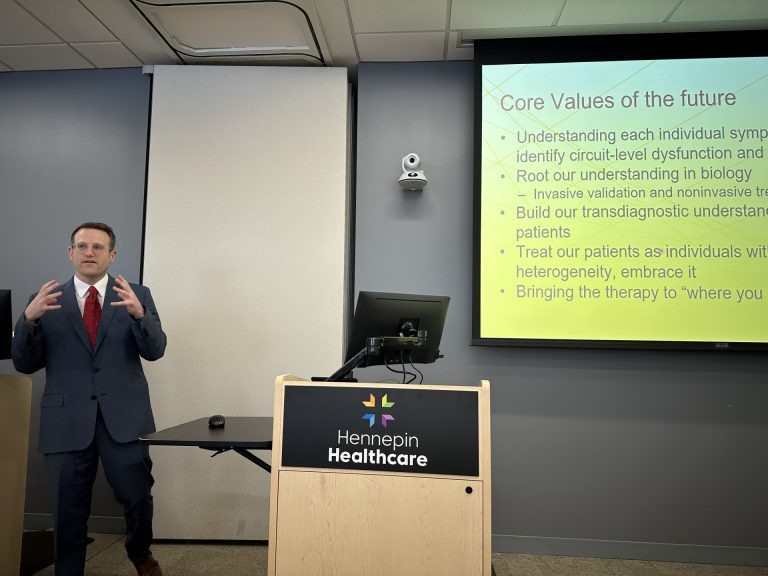Hennepin Healthcare Research Institute (HHRI)
Dr. David Darrow talks the future of Traumatic Brain Injury (TBI) research
Photo: Neurosurgeon researcher, Dr. David Darrow presenting this research at “The Future of TBI: The Intersection of Neuromodulation and Cognitive Neuroscience for Restoring Function” at Hennepin Healthcare during Brain Injury Awareness Month on March 28, 2024
GOAL: Dr. David Darrow informs attendees about the latest research in Traumatic Brain Injury (TBI) and what he and his team are doing to improve its aftermath.
Through his research, he hopes to “help foster what I think is somewhat of a paradigm shift in how we think about TBI as part of a larger conversation about brain injury and brain illness."
Dr. Darrow is an attending neurosurgeon at the University of Minnesota, Rockswold-Kaplan Endowed chair at Hennepin Healthcare, and director of the Restorative Neurotrauma Lab (RNL)at HHRI, which focuses on restoring function after traumatic brain injury and spinal cord injury, using electrophysiology, and neuromodulation. RNL conducts non-invasive and invasive studies and is most recognized for the E-STAND (Epidural Stimulation After Neurological Damage) trial, which uses spinal cord stimulation to restore function after injury.
A study that makes you smarter? That is what Hennepin Healthcare Research Institute (HHRI) Principal Investigator David Darrow, MD, MPH, is working towards in the StiMulating After Recovery from Traumatic brain injury (SMART) study.
The SMART study, which aims to develop noninvasive therapies to improve cognitive abilities and decision-making after mild to moderate Traumatic Brain Injury (TBI), is one of many TBI topics that pain and functional neurosurgeon and neuroscientist, Dr. Darrow discussed at his presentation entitled, “The Future of TBI: The Intersection of Neuromodulation and Cognitive Neuroscience for Restoring Function” at Hennepin Healthcare during Brain Injury Awareness Month on March 28, 2024.

Fast facts on TBI
- TBI is still very prevalent, impacting 1.7 million cases per year.
- It’s the cause of 1/3 of deaths among young people, especially young males under the age of 45 performing reckless activities.
- It affects males far more than females, but females are the most influenced by the long-term consequences.
- There is NO primary treatment for TBI. Prevention is the best treatment. If that fails, it’s best to focus on secondary injury prevention.
- Ensure adequate blood flow to the brain.
- Maintain the brain’s normal activity.
- Once a patient is stabilized, it’s simply a waiting game. “Trauma is rarely isolated to the brain. The body fixes and organizes and heals on its own,” says Dr. Darrow.
Treatment & recovery
The aftermath of TBI
- TBI produces physical, cognitive, and behavioral effects such as mental fatigue, depression, anxiety, post-traumatic epilepsy (PTE), headaches, and more.
- Mental fatigue is the most common side effect of TBI, producing more sensitivity to stress, slowness of thinking, mood swings, memory problems, sleep disturbances, and more.
Ways of researching/treating TBI
- Using methylphenidate (Ritalin) as a short-term solution for those with low dopamine to increase cognitive efforts. Where tasks seem easier to perform, but do not improve their ability to complete the tasks.
- Research studies that use cognitive effort discounting task (COGED), is a task that measures how a participant values easier or harder tasks. Measuring cognitive effort and performance of a decision-maker based on how likely they are to engage in a more demanding task.
- Transcranial alternating current stimulation (tACS), where stimulation at a beta frequency of 23 Hz is targeted to improve cognitive performance and task completion rates. (SMART study methodology)
- Research is combining both COGED, a way to measure cognitive performance, and the treatment of tACS to determine if there is a solution for the compounding long-term aftermath of TBI.
Waves of the Future
- Expect that patients will have differences in behavior and symptoms and embrace those differences by creating individualized approaches to treatment.
- Noninvasive neuromodulation (stimulating nerves to help manage pain)
- Increasing the brain’s ability to rely more on the decision-making concepts of exploration (open to gathering new information) versus exploitation (relying on past information to drive decision-making).
- Bring therapy to “where patients are” – use cost-effective, tangible therapies that are accessible to patients.
Watch the complete presentation here.
